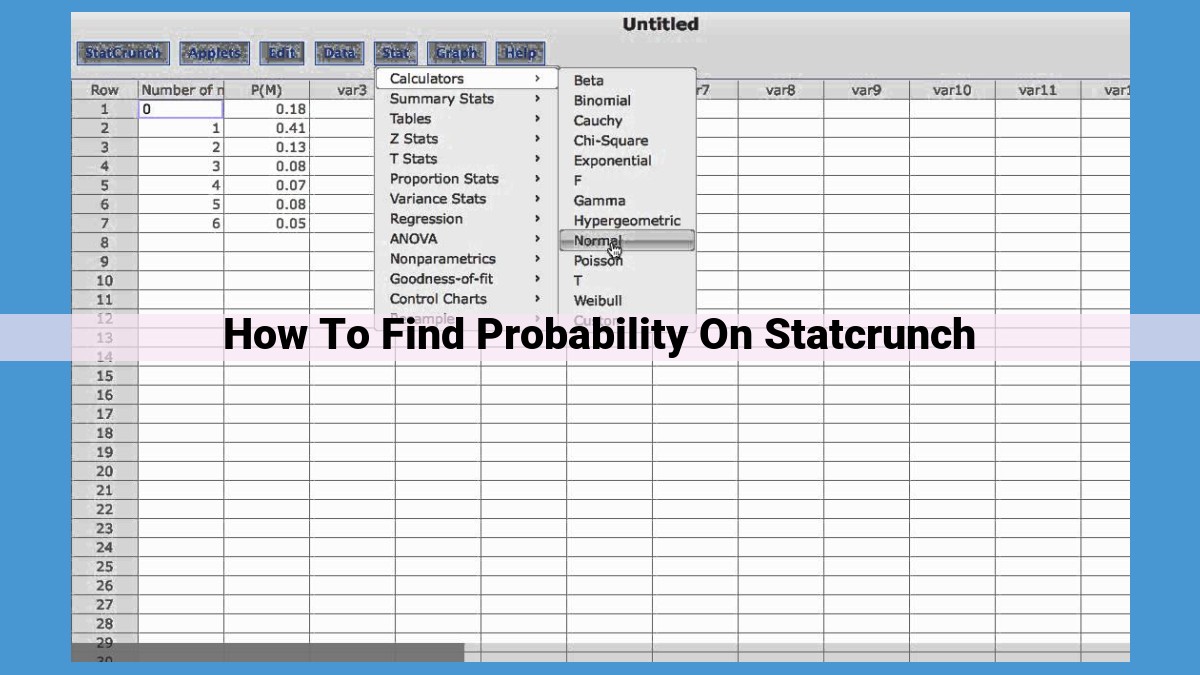To find probability on StatCrunch, users first understand theoretical, empirical, and subjective probability. Then, they use StatCrunch’s data manipulation and analysis capabilities to input data, select a probability distribution, and calculate probabilities. The software offers various built-in functions to compute probabilities for different distributions. Users can then interpret the probability values obtained to understand their implications in real-world scenarios.
Understanding Probability: Unlocking the Secrets of Chance
In the realm of uncertainty, probability serves as our guide, illuminating the likelihood of events and empowering us to make informed decisions. There are three main types of probability, each offering a unique perspective on the randomness of our world:
Theoretical Probability: The Power of Deduction
Theoretical probability, rooted in mathematical equations and assumptions, provides a precise prediction of the outcome of an event. It relies on counting the possible outcomes and determining the fraction that corresponds to the desired event. For instance, the probability of rolling a 6 on a standard six-sided die is 1/6, since there is only one favorable outcome out of six possible outcomes.
Empirical Probability: Lessons from Experience
Empirical probability, on the other hand, is based on observed data and experimental outcomes. It estimates the likelihood of an event by relying on the frequency with which it has occurred in the past. For example, if you toss a coin 100 times and it lands on heads 60 times, the empirical probability of getting heads is 0.6.
Subjective Probability: Embracing Intuition
Subjective probability, unlike its theoretical and empirical counterparts, incorporates personal beliefs and expert opinions. It reflects an individual’s judgment about the likelihood of an event, often based on experience, knowledge, or gut feeling. For instance, a meteorologist might assign a subjective probability of 70% to the chance of rain tomorrow based on their analysis of weather patterns and historical data.
Probability plays a vital role in our everyday lives. It helps us:
- Assess risk: Calculate the likelihood of accidents, illnesses, or natural disasters.
- Make decisions: Determine the best course of action based on potential outcomes and their probabilities.
- Understand phenomena: Explain the behavior of random processes, such as the distribution of test scores or the spread of disease.
- Predict the future: Forecast weather patterns, economic trends, or electoral outcomes based on historical data and probability models.
By understanding the different types of probability, we gain a powerful tool to navigate the uncertainties of life. Probability empowers us to make better decisions, comprehend the world around us, and plan for the future with greater precision and confidence.
StatCrunch: Your Swiss Army Knife for Probability Calculations
In the realm of probability, navigating the complexities can be daunting. But fear not, for StatCrunch emerges as your trusted companion, ready to unravel the mysteries and empower you with its intuitive tools.
StatCrunch: A Statistical Powerhouse
Imagine a statistical software that seamlessly integrates data manipulation, analysis, and probability calculations. StatCrunch is precisely that! It empowers you to effortlessly import, organize, and explore your data like a seasoned pro.
But what truly sets StatCrunch apart is its mastery of probability calculations. Whether you seek to unravel the intricacies of binomial distributions, delve into the mysteries of normal distributions, or explore the nuances of countless other distributions, StatCrunch has got you covered.
Unveiling the Secrets of Probability
StatCrunch believes in making complex concepts accessible. It provides an array of helpful functions that demystify the world of probability. From calculating probabilities for individual values to determining the likelihood of events, StatCrunch streamlines the process, revealing the secrets of probability one step at a time.
Navigating the Probability Maze
Let’s embark on a step-by-step journey through StatCrunch’s probability-calculating prowess:
1. Data Input: Import your data or manually enter it into StatCrunch’s user-friendly interface.
2. Distribution Selection: Choose the distribution that best aligns with your data’s characteristics. StatCrunch offers a comprehensive selection, ensuring precision in your calculations.
3. Probability Calculation: Unleash StatCrunch’s built-in functions to compute probabilities with ease. The software’s intuitive design makes even the most intricate calculations a breeze.
4. Interpretation: Embrace the clarity and understanding StatCrunch provides. Its straightforward results empower you to confidently interpret probabilities, unlocking the insights hidden within your data.
With StatCrunch by your side, the world of probability transforms from a daunting enigma into a realm of accessible knowledge and actionable insights.
Step-by-Step Guide to Finding Probability on StatCrunch
Understanding probability is crucial in various fields, from science and finance to daily decision-making. StatCrunch emerges as a powerful tool that simplifies probability calculations, enabling us to make informed decisions.
a. Inputting Data
Importing data into StatCrunch is straightforward. You can uploadFile, enter data manually, or copy-paste it from other sources. Each row represents an observation, and each column represents a variable. Ensure the data is organized and cleaned for accurate probability calculations.
b. Selecting Distribution
StatCrunch supports numerous probability distributions, each with its unique characteristics. Choosing the appropriate distribution is essential for reliable probability estimates. Common distributions include:
- Normal distribution: Continuous, bell-shaped curve
- Binomial distribution: Discrete, number of successes in fixed trials
- Poisson distribution: Discrete, number of events in a fixed interval
c. Calculating Probability
StatCrunch offers multiple built-in functions to compute probabilities. The functions depend on the selected distribution. For example, to calculate the probability of a specific value in a normal distribution:
=normalcdf(x, mean, sd)
where:
xis the value of interestmeanis the mean of the distributionsdis the standard deviation
d. Interpreting Results
The probability value obtained from StatCrunch indicates the likelihood of an event occurring under the specified conditions. Probabilities range from 0 to 1:
- 0: Impossible event
- 1: Certain event
- Between 0 and 1: Degree of likelihood
Interpreting probabilities requires context and consideration of the specific situation being analyzed.
StatCrunch empowers you to effortlessly calculate probabilities, bridging the gap between theoretical concepts and practical applications. By following these simple steps, you can leverage StatCrunch to make informed decisions, understand the likelihood of events, and gain a deeper understanding of the world around you.
